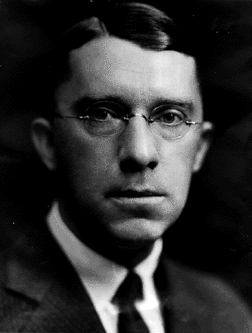
Paul B. Dunbar, Ph.D.
5/6/1944 - 5/31/1951
Paul B. Dunbar was born in Lebanon, Pennsylvania, on May 29,
1882. He graduated from Gettysburg College in 1904. He received
his Ph.D. in chemistry from Johns Hopkins in 1907 where he studied
under Dr. Ira Remsen. After passing the stringent Civil Service
examination for analysts, Dunbar was appointed in 1907 as one
of the original group of chemists to undertake enforcement of
the Food and Drugs Act of 1906. A food chemist, Dr. Dunbar started
his career in the lab of the Bureau of Chemistry in Washington.
He met his first wife, Alice L. Davison, also a Ph.D. chemist,
from the University of Pennsylvania, while working in the laboratory.
In 1915, Dunbar became assistant to W. G. Campbell, chief of the
Eastern Food and Drug Inspection District. In 1925 he became Assistant
Chief of the Food and Drug Administration, then headed by Dr.
C. A. Browne.
When FDA was established as a separate enforcement bureau in
1927, Campbell became Chief and Dunbar was appointed Assistant
Chief. When Campbell received permission from the New Deal administration
to propose legislative corrections to the outdated 1906 federal
food and drug statute, it was Dunbar who convinced him to replace,
rather than rewrite the original law. Following passage of the
1938 Food, Drug, and Cosmetic Act, Dunbar was named Assistant
Commissioner of Food and Drugs. He was promoted to Associate Commissioner
in 1942. Following Campbell's retirement in 1944, Dunbar was appointed
Commissioner.
During World War II, Dunbar willingly assumed the task of testing
drugs for the military. He declined, however, to ask for additional
funds for war work, considering it a patriotic contribution owed
to the country. Wartime economics also prevented the agency from
achieving adequate civilian consumer protection. By the end of the
war, FDA resources, already meager, lagged behind even further.
His tenure as commissioner included launching the era of the "miracle
drugs." Sale of dangerous drugs without prescription became
a major issue during his administration, and the problem was not
resolved until the 1951 passage of the Durham-Humphrey amendment
which defined drugs requiring a prescription. He was one of the
first to predict the need for a narcotic-type control over drugs
such as barbiturates and amphetamines, which became law in 1965.
Discussions with Congressman Keefe (D-Wis.) resulted in the appointment
of a Select Committee to investigate the use of chemicals in foods,
headed by Rep. James Delaney (D-NY). It was the amendments growing
out of these hearings (Miller Amendment 1954; Food Additives Amendment
1958; Color Additives Amendment 1960) which at the time of his
death provided for continuous testing of food and drugs in the
Food and Drug Administration's laboratories. Dunbar remained a
life-long member of the American Chemical Society, the Association
of Food and Drug Officials of the United States, and Phi Beta
Kappa.
In 1951, Dunbar retired at age 69 and received the Federal Security
Agency's distinguished service award for "outstanding leadership
in the constructive administration of food and drug laws."
Oscar Ewing, his superior, called him the "indomitable champion
of the American consumer." Dunbar died on August 22, 1968
at his home in Rockledge, Florida after a long illness.